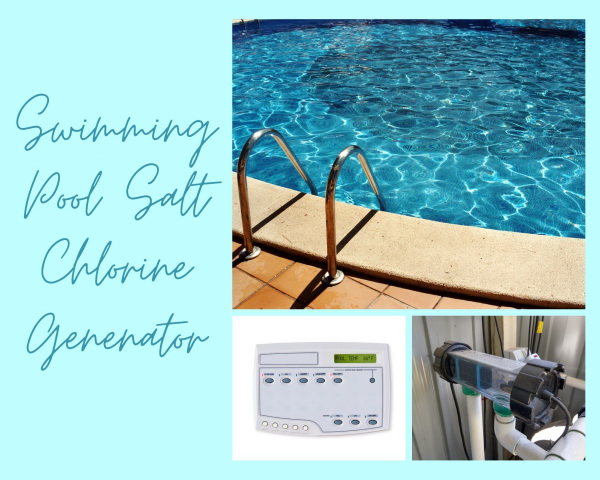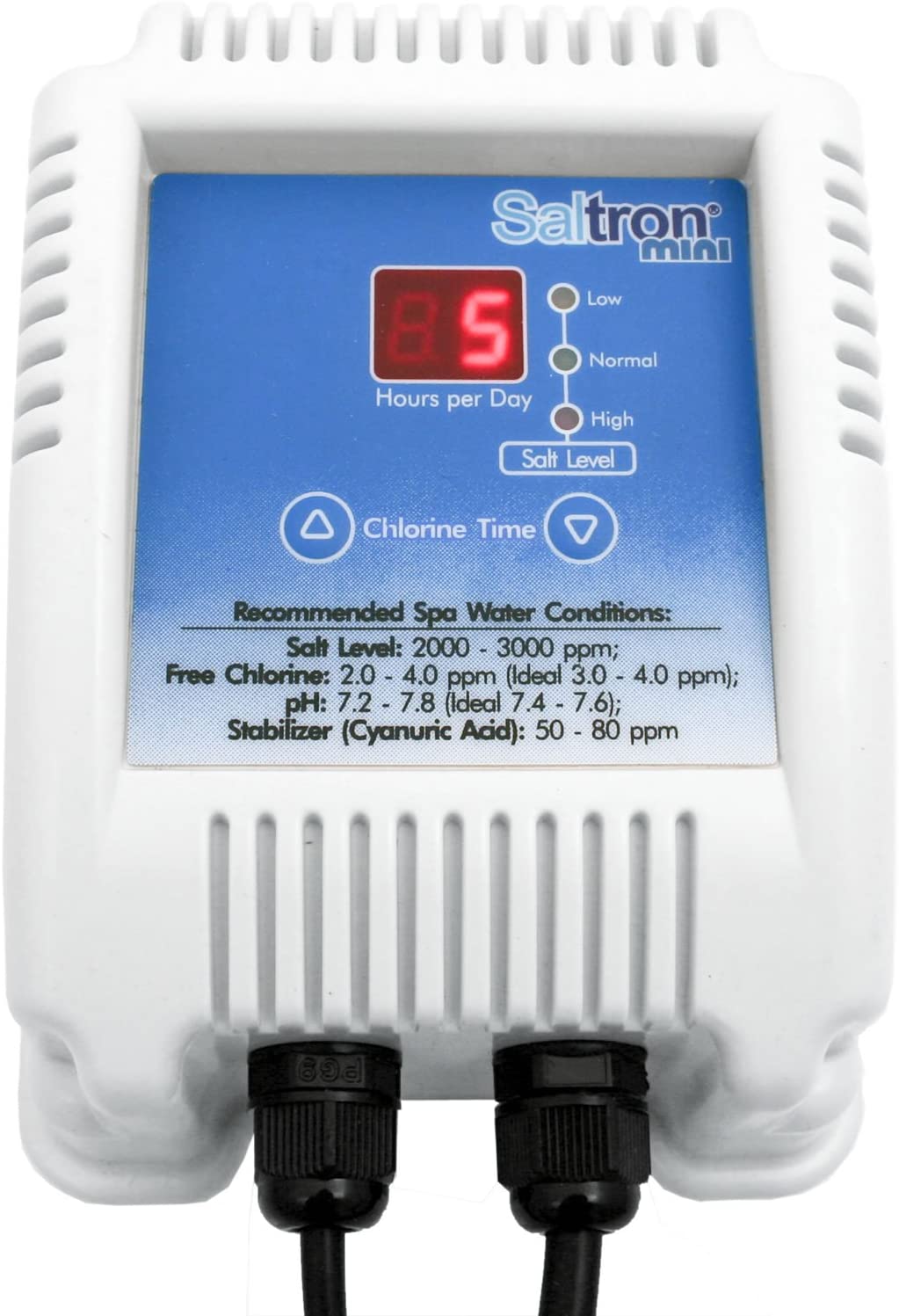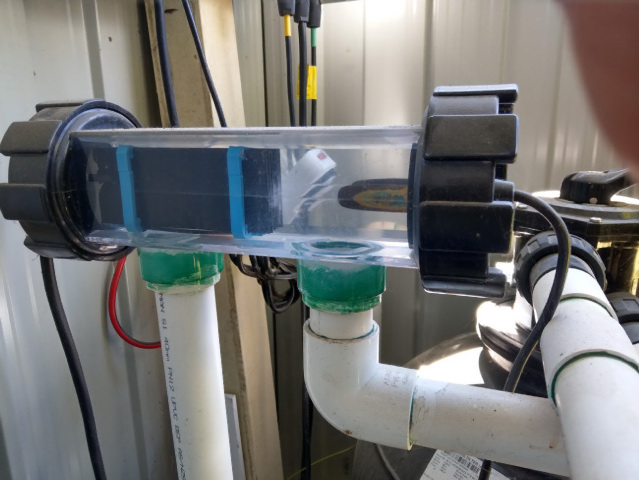Congratulations on your new saltwater pool! Now…how does this thing work? One of the first things you need to understand when it comes to saltwater pools is how to set the power level, or percentage level, of your saltwater chlorine generator (SWG for short and sometimes called a chlorinator).
Setting the power percentage for a saltwater chlorine generator is a trial and error process. Start by testing the pool water to ensure proper balance. Next set the power percentage to 30-50% and leave for 2-3 days. Retest the water. If the chlorine is too low, increase the power, if it’s too high, decrease it.
There’s a bit more to it than this simple summary though. There are many factors that will help you determine the power level (or percentage) of your saltwater generator.
Let’s take a look…

Article Contents
How Does a Saltwater Pool Work?
First a little background.
To make things simple, let’s understand that a saltwater pool is a chlorine pool. You have purchased a mini chlorine production plant and had it installed into your pool’s plumbing system.
So, instead of adding chlorine manually or through a dispenser to care for your pool, your new SWG (saltwater generator) will make the chlorine that is needed. It does this by turning the salt into chlorine and once the chlorine has done its job, it reverts to salt so the process can occur over and over.
Sounds simple right? Well, it is but it isn’t. When I sat down to write this article, I thought it would be simple, as I’ve been using a salt chlorine generator of some kind my entire career. A lot has changed in 29 years, especially in the last few years. Understanding the following will make it simple.
After the necessary equipment has been installed and the appropriate salt level has been achieved (accomplished by adding bags of pool grade salt to the pool’s water), what should the salt level be?
Related Reading: Beginners Guide to Saltwater Pool Maintenance
What Should the Salt Level Be?
That’s one thing that has changed, as some of the newer systems operate (produce chlorine) with salt levels (measured in ppm or parts per million) as low as 800 ppm up to a high of 8000ppm. Others have requirements between 3000 to 4000 ppm.
A salinity level of 3000-4000 ppm is common
Salt level requirements vary by manufacturer and/or model of SWG. Refer to your manual for salt level requirements. You can test your salt levels with saltwater test strips like this product here:
- Quickly test your saltwater pool's salt levels
- Accurate measurements for salt levels from 400 to 7,000 ppm
- Easy to use, no measuring & counting drops
Now that the pool’s water has the appropriate salt level, it is time to start making chlorine.
Are You Using a Standalone or Smart Chlorine Generator?
Most salt systems of the past were standalone units that begin producing chlorine once the pool pump starts circulating water. You would simply set the percentage of chlorine production required. The SWG will produce chlorine at the selected percentage until the pump turns off.
Today, many pools are being built or upgraded to include smart controls and variable speed pumps, allowing the salt systems to be programmed to turn on and off during the pump run times if desired.

What Does the Saltwater Generator Percentage Mean?
Back to the percentage of chlorine output. What does it mean? This will also depend on the unit installed.
Let’s say you set it at 35%…does that mean the cell is operating at 100% output for 35% of runtime or does it mean it is in operation at 35% output for 100% of the runtime? Or is it a different equation altogether?
There are also a bunch of other numbers on your saltwater generator, if you want to know what the numbers mean, check out our article: What Do The Numbers In A Saltwater Generator Mean?
What Percentage Should I Set the Chlorine Generator To?
So, the big question is what percentage do I set for my pool? Unfortunately, there is no standard answer, and there will be some trial and error and adjustments along the way. Most pool professionals recommend starting at 30-50% power.
It is difficult to give a one size fits all answer, as every pool is a very different situation.
Factors that Affect Power Level Setting
Some of the factors that affect what power level or power percentage you need to set your chlorine generator (SWG) include:
- Does the pool use other sanitizers?
- What is the Salt Cell Size?
- Does the pool use a pool cover?
- How many people and how often is the pool used?
- Is the pool kept clean or do you let debris build up?
- Is the water chemistry ideal?
- What is the water temperature?
Sanitizer (One or Multiple)
Most pools today have more than one form of sanitizer, therefore reducing the amount of chlorine that is needed to properly sanitize the water.
Salt Cell Size
Your SWG has a component that makes the chlorine which is called the cell. Cells are rated by the size of pool. Some systems are rated for a 15k gallon pool while others may be 20k, 25k or 40k even 60k. It is commonly best to have an oversized cell.
An undersized salt cell will need to be run longer and at high power percentages than an oversized cell. It’s usually best to select a larger cell. This will mean you can run the saltwater generator at a lower percentage and for less time. As a result, you’ll have a salt cell that lasts longer before wearing out.

Pool Cover Use & Bather Load
Some pools have an automatic cover, which reduces the amount of chlorine that will need to be produced, some pools are indoor pools, some are used by large groups of families and friends while others may be enjoyed by one or two people all year. The percentage will need to be set to achieve the desired output that your individual situation calls for.
Pool Maintenance and Water Chemistry
Another factor that will go into selecting your individual percentage of chlorine production is pool maintenance and proper water chemistry. If you have a pool that consistently has leaves and debris left in the skimmer baskets, floating in the water or lying on the bottom, you will use more chlorine (requiring a higher percentage or longer run time) than one that is properly cared for.
Having the proper CYA (cyanuric acid) level, which is sunscreen for your chlorine (not needed for indoor pools), will allow for less chlorine production to be needed. Borate and enzymes are becoming more popular today in pool water chemistry, allowing for reduced chlorine production as well.
High phosphates can create havoc for a SWG.
Don’t be nervous, we’ll touch on those topics down the road in another article.
Water temperature may also come into play, which would explain why one manufacturer has incorporated a temperature compensation feature in their units.
How to Set a Chlorine Saltwater Generator Percentage
Let’s get back to setting your chlorine production percentage:
1. Set Your Pump Runtime
Start by determining your pump runtime to properly circulate your water. The goal should be to turn over the pool water volume twice a day. Some will say once a day, while most commercial municipalities have requirements set at four times a day.
This is where having a variable speed pump will make things easier. Running a pump at lower speeds 24 hours a day is a lot less expensive then running a single speed pump for 12 hours a day.
This will also allow for consistent chlorine production at a lower output percentage…plus a stream will always look better than a pond. A little math will be required to calculate this.
Check out our blog for more info:
2. Balance the Water
Swimming pool water should be balanced and chlorinated to proper levels prior to turning on the SWG.
- Chlorine: 1-5ppm
- Stabilizer/Cyanuric Acid: 30-60 ppm
- pH: 7.4 – 7.6
- Total Alkalinity: 80-120 ppm
- Water temp: 70°F or above
Swimming pool water should be balanced and chlorinated to proper levels prior to turning on the SWG. The chlorinator is there to maintain your chlorine residual level.
Start with your free chlorine level on the high end of 3ppm. This will allow you some time to determine your ideal percentage setpoint if not set correctly after day one.
Pool water temperature should be 70°F or above. While some saltwater systems shut down at lower pool water temperatures, some also reduce production while the water is cooler.
It’s also important to make sure the pH, stabilizer and total alkalinity (TA) are correct. If they’re not, the chlorine won’t be able to effectively do its job.
3. Set the Saltwater Generator Power Percentage/Level
Choose a lower percentage to start if using a variable speed pump say like 25% up to 50% if using a single speed pump on a timer. Turn your system (pump and SWG) on according to your chosen pool volume turnover runtimes. Go for a swim in the next 24 hours, if possible.
4. Wait 1-2 Days & Retest the Water
On day two or three (after 24-48 hours), complete another water test using a good quality test kit.
If you have selected the correct percentage on your saltwater generator, your free chlorine reading should still be on the high side of 3ppm, as it was before starting. If needed, turn up or down the SWG percentage depending on the water test results.
5. Wait Another 2 Days & Retest the Water
Test the water again after 48 hours and note if the chlorine levels have increased or decreased. Increase or decrease the power percentage as needed. The more often that you test the water in the first few days or weeks, the sooner you will learn your saltwater pool chemistry and appreciate its ease and popularity.
6. Set the SWG Percentage to Your Own Preference
Now you can slowly raise or lower the percentage output to match your own personal preference, depending on water chemistry and additional alternative sanitizers which often can allow for a lower chlorine residual.
Pro tip: keep in mind that once you have found a percentage that works for you, it may change over the course of time based on bather load (pool use), seasonal changes as well as other factors.
Remember to follow your manufacturer’s recommendation on proper cell maintenance.
Welcome to a saltwater pool…enjoy!
Related Reading: 8 Tips To Maintain A Saltwater Chlorine Generator



Thanks for a comprehensive post.